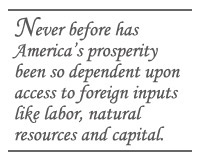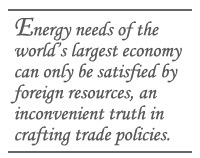Unilateral Delusions
Unilateral Delusions

NEW YORK: While it's common for US politicians to spout economic populism during elections, the anti-trade sound bites heard during this year's campaign are dangerous given America's thickening ties with the rest of the world. In particular, a swelling wave of protectionist sentiment on Capitol Hill, epitomized by the failure to pass trade agreements with Colombia and South Korea, as well as tightening restrictions on foreign investments and the global flow of skilled labor, poses significant risk to US economic well-being.
Never before has America’s prosperity been so dependent upon access to foreign inputs like labor, natural resources and capital. In the end, the US president and Congress must realize a simple truth: Despite the problems they create, the global ties that bind the US remain at the heart of America’s prosperity.

Although America’s workforce is among the world’s most productive, the US hardly maintains a monopoly over the best and brightest. Accordingly, the workforce of many US companies has become more global in recent decades. America’s overseas workforce totaled roughly 10.3 million in 2005, the last year of available data. This figure is greater or equivalent to the total workforces of many nations, and even higher after accounting for the thousands of foreign workers employed by US firms under non-equity arrangements. The bulk of these workers are in developed nations; in Europe alone, US affiliates employed more than 4.3 million workers in 2005, in excess of the combined affiliate work force in Latin America and developing Asia.
America’s demand for foreign workers goes beyond the millions on US foreign affiliate payrolls. More than 20 million foreign-born workers – legal immigrants, illegal immigrants and temporary skilled workers – are employed in the US, a labor pool equal to 15.7 percent of the US labor force. In sectors like agriculture, construction, hotels and meat packaging, immigrants comprise an even larger percentage of the total workforce. Immigrants also fill the ranks of skilled workers required in sectors like medicine and technology. Without foreign workers at home and abroad, US economic growth would stagnant.
For a nation endowed with one of the richest, most diverse supplies of natural resources, America’s dependence on other nations for raw materials, particularly petroleum, has grown in recent decades. Among strategic resources like graphite, manganese and mica, the US depends 100 percent on foreign supplies. However, America’s biggest resource challenge lies with its dependence on foreign oil.

The economics of oil are straightforward: US consumption of crude oil and petroleum products jumped 21 percent between1990 and 2007, while domestic production plunged by more than 30 percent. The production-consumption imbalance was offset in large part by soaring oil imports, which increased 68 percent between 1990 and 2007. Last year, America’s oil import bill totaled $237 billion, up 164 percent from the amount notched in 2000.
The Middle East remains an important variable in the overall oil equation by virtue of its massive reserves, nearly two-thirds of the global total. America’s proven reserves – 3 percent of the global total – are miniscule in contrast, leaving the US vulnerable to supply disruptions in not only the Middle East, but other parts of the world, notably Africa.
Soaring oil prices have fostered an investment surge in alternative energies worldwide, though the ultimate impact, which new technologies will emerge as reliable, remains uncertain. More certain is this: Today, the energy needs of the world’s largest economy can only be satisfied by foreign resources, an inconvenient truth that must be borne in mind when crafting trade and investment policies.
By drawing heavily from the global savings pool, the US has been able to live beyond its means for years. Net capital inflows into the nation averaged $682 billion annually this decade versus an annual average of $139 billion during the 1990s. This capital injection enabled consumers to purchase new cars and homes, businesses to finance new investments, and the government to enjoy both large military outlays of guns and the butter of tax cuts. Foreign capital, in other words, has been a key staple of US economic expansion this decade. Foreign capital has been a crucial input into recapitalization of US banks stung by the subprime meltdown and subsequent credit market fallout.

While the US remains a magnet for foreign capital, the bad news is this: America’s debt to the rest of the world has never been larger. The interest expense on America’s foreign debt totaled a record $165 billion last year, more than double the level in 2002. Debt servicing on foreign obligations is now among the largest line items of the US federal budget deficit. Many of America’s key trading partners are also key creditors, another stubborn fact that must be borne in mind when crafting trade policies.
In addition to America’s rising dependence on foreign inputs, US firms increasingly depend on foreign markets for growth. Overseas markets for a host of goods and services are growing at a faster rate than in the US. China and India are just entering the automobile era; between 2004 and 2007, unit sales of General Motors in China more than tripled; Ford’s sales jumped nearly fivefold. Cell phone demand in Africa has exploded, accelerating build out of Africa’s technology infrastructure, including internet use, which benefits US technology leaders. Demand for computers soars in nations like Poland and Turkey, bringing revenue for US technology giants. Mexico is among the largest markets in the world for US beverages, to the benefit of US beverage companies like Coke, Pepsi and various brewing companies. Europe and Japan remain key markets for a host of American firms.
Today, the foreign reach of corporate America has never been greater, with US multinationals operating more than 23,000 foreign affiliates. Given this infrastructure, the primary means by which companies deliver goods and services to foreign customers is not through trade, but through foreign affiliates. The latter totaled an estimated $5 trillion in 2007, well above total US exports of $1.6 trillion.
Future trends are clear: Successful US companies will be those that access and leverage foreign markets and resources; however, if the US veers down the path of protectionism, this challenge will become more difficult.

The US must reprioritize its trade policies to secure foreign inputs so critical to its economic prosperity. At a minimum, America must remain the global champion of free commerce, resisting the impulse to adopt measures at home that restrict cross-border trade and investment flows. The trade agenda for the next president should include restoration of Trade Promotion Authority – a step that would signal to the rest of the world that the US is committed to pursuing free trade agreements. Given the failed Doha Round, the US should also recommit itself to the World Trade Organization.
Election season may not be the ideal time for thoughtful trade action. Once installed, the next administration ought to seriously consider reviving the idea of Free Trade Area of the Americas and upgrading the North American Free Trade Agreement. Closer ties with the Latin and South America would go a long ways in securing America’s energy future, in addition to providing the US access to the region’s abundant resources. The pursuit of a single transatlantic marketplace should also be high on the next administration’s trade agenda, cementing ties with Europe. To maintain its prosperity the US must resist the siren song of isolationism that emerged during this election campaign.
Joseph P. Quinlan, a veteran Wall Street strategist and economist, is an adjunct fellow at the Pacific Council on International Policy.